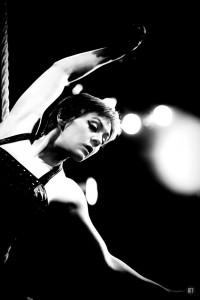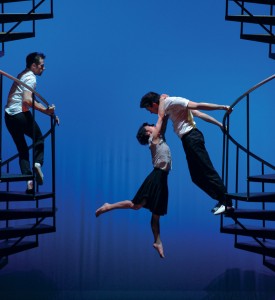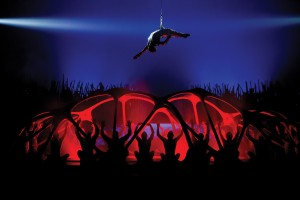Running Away to Join the Circus – Three stories: Robbie Curtis, Jeff Hall and Lisa Natoli - Vancouver Ballet Society
- Home
- Features 2015 - 2019
- Running Away to Join the Circus – Three stories: Robbie Curtis, Jeff Hall and Lisa Natoli

by Robin J. Miller
The dance world is a fluid place these days, with hip-hop seeping into contemporary, contemporary into ballet, and hints of what looks very much like circus beginning to permeate them all.
It goes the other way, too. Circus used to exist as a world unto itself, a series of novelty acts thrown at the audience one after the other as pure entertainment, without any pretence of being art. Today, however, circus is a very different place, in part because of the many highly trained dancers who have, by choice or by chance, found themselves a satisfying new place in that world.
As a boy, Robbie Curtis remembers being “absolutely hungry for physical stuff. I was always juggling, I took tap dancing, acrobatics, anything with movement.” Then he fell hard for dance, majoring in classical and contemporary at New Zealand School of Dance and later spending a year with Footnote Dance Company in Wellington, New Zealand, followed by freelancing back in his native Australia with the Australian Ballet and Shaun Parker & Company, among others.
“I was really interested in how to use the body to tell stories,” he says, “but I discovered there was a limit to the physical vocabulary in dance. I think I struggled a little bit when I was dancing. I wanted to push the boundaries of physicality, and a lot of choreographers were not open to that. Some were excited about bringing in new movement, but others said ‘no tricks, no tricks.’ But a trick can be a pure experience. A handstand can add deep meaning. It’s all in how you place it.”
Today, 27-year-old Curtis is primarily a base (an incredibly strong acrobat who anchors one or more flyers on hands, arms, shoulders, back, knees, feet), although he tumbles and juggles, too, with Circa, one of the busiest contemporary circus companies in the world, based in Brisbane, Australia. In one six-month period alone, from July to December 2015, Circa premiered three new pieces, including one based on Monteverdi’s Baroque opera Il Ritorno, and had multiple casts each performing different full-evening works in the United Kingdom, Germany, Belgium, Australia, New Zealand, the United States and Canada.

“For me, it’s all about how you can push the physicality of it,” says Curtis. “It’s about how far you can fly, how you can get your body to go to the next level. But it’s the mix I find really interesting, the physicality of circus along with the ability to express something with your body.” He does acknowledge, however, that circus is “playing a bit of catch up” with dance, especially with such revelatory artists as the late Pina Bausch, “who went to a very different place, emotionally and conceptually.”
“Circus started with clowns, tents and animals, as well as acts with spectacular tricks and skills,” he says. “But it’s going through a renaissance and it won’t be long until circus as an industry is exploring how to be deeper and more conceptual –– pushing away from just skills toward humanness, human stories. Circus can move the heart and soul.”
Curtis also finds touring as a circus performer more satisfying than the touring he did as a dancer. “Touring life is difficult, no matter what,” he says. “But the traditional circus was based on the family, on family acts that toured together, and that carries through today. Love is encouraged within touring life. The circus world is a bit grungier than the dance world — some of the venues are a bit raw, and you don’t just put on your makeup and go onstage or leave right after (with Circa, we pull the rigging down and bump out) –– but the bonds you have with other ensemble members are incredibly strong.”
To some degree, those tight bonds also come from knowing that your life is literally in your fellow performers’ hands. “I like the adrenaline,” says Curtis. “There’s so much more risk, so much more danger in circus, and I guess I am attracted to that, too.”

While greater risk and danger were not in Lisa Natoli’s mind when she transitioned from dance to circus, greater artistic satisfaction definitely was. Natoli had always considered her body her canvas and dance her meaning for life, but years in New York City working as a freelance contemporary dancer with a variety of choreographers finally left her “completely heartbroken.”
“I was working at a day job 40 hours a week and dancing 40 hours a week,” she says, barely scraping together a living as so many dancers do. But the trouble was also on the artistic side. “You work and work for a whole year for one show,” Natoli says, “which was just not artistically fulfilling. I wanted to constantly make new work, and at the same time I felt limited by always doing other people’s work. I felt empty. And it was not making me a better dancer.”
A friend suggested Natoli try working with aerial silks –– long, flowing cloth suspended up to 12 metres above the (net-less) ground that allows flyers to do dramatic and often elegant holds and wraps as well as heart-thumping drops. She became hooked. “There are tighter parameters when you are working with an apparatus,” she says. “There are only so many things you can do. But by limiting the choices you can make, it feels like you gain more freedom.” She likens it to technique in classical ballet; it’s strict, but once you have mastered it, “it frees you up to create within it.”
Since 2009, Natoli has been artistic director of her own company, Lisa’s Bright Ideas, and has presented solo and ensemble pieces using silks, ropes and hoops in both traditional and non-traditional venues in and around New York and beyond. “The money is better,” she says. “There is more work for me as an aerialist because of the cabaret scene in most big cities. It’s an act that can be done virtually anywhere.” She also feels she has “a stronger voice as an aerialist. I think I was always more of a choreographer than a dancer and now, even if a piece fails, it feels like I am working toward something.”
At age 42, while her body requires more maintenance to keep up with the physical strength and endurance required to be an aerial artist, she also feels she will have a longer career than she would have had in dance. “Circus has traditionally been a family business,” she says. “There have always been generations of performers, including those in their 50s and older. I think circus is more forgiving or accepting of age, and certainly of body type.” Natoli’s dance training (including the Alvin Ailey certificate program and a dance degree from the University of Iowa) and years of dance performance do still come back occasionally to haunt her. “I miss the way dancers think,” she says, a yearning that Cirque du Soleil choreographer and director Jeff Hall knows well.
Raised in Montreal, Hall had an ulterior motive in first taking up dance — he wanted to improve his frisbee playing (he was the Canadian Freestyle Frisbee Champion of 1989 and 1990). The frisbee also led him, in 2005, to his first job with Cirque du Soleil, staging a 45-second flying frisbee sequence for one of the company’s permanent Las Vegas shows, The Beatles LOVE. The sequence was ultimately cut, but a new circus career was born.

“This is my second life,” says 57-year-old Hall, whose first life as a fiercely physical dancer for such cutting-edge companies as Quebec’s Carbone 14 and PPS Danse was brought to an abrupt end by a fall that broke his back in 2002. Over the past 10 years, he has choreographed Cirque du Soleil’s big touring show Totem, directed by Robert Lepage, as well as the acrobatic sequences in ZAiA, which ran for four years in Macau, China. He has also written, choreographed and directed his own circus shows in Chile and Canada, most recently Ruelle (alley or backstreet) for Montreal’s Complètement Cirque Festival in July 2015.
“The traditional circus is based on individual acts that are intended to ‘wow’ the audience,” he says. “That’s still a strong tradition I try to work against. My job, as I see it, is to bring my dance training and sensibility to circus performers, to help train them to be artists, not just acrobats. I am a person in love with dance and the movement of dancers. When you work with dancers, you realize they are hungry to get it right in their bodies, they push themselves to get it right, internally, emotionally, physically, and they are incredibly hard working. But I also understand and love the language of circus and the way acrobats work. They work and work and work on a skill for years until they master it. It’s mind-boggling what they do.”
But it does have limits. After mastering a trick or skill, some circus artists think that’s it, they’re done. Hall wants them to reach for more. He works to take their tremendous physicality and add to it the elements that will help make their work exceptional. “The concept of stretching a movement to the ends of their fingers and toes is hard to get across to a circus artist,” Hall says. “Musicality, too, is a foreign concept to most of them. Maybe one in 10 circus performers get it, but that one will eat it up. There’s something about seeing them grow onstage so quickly that is magical. Many are undernourished as artists; they are starved for something else. Dance helps nourish them.”

